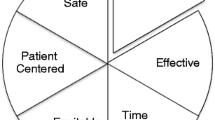Abstract
The rising cost of health care has created great interest in developing methods to increase the efficiency of health care organizations. Despite this interest most analyses of prospective payment and other programs designed to control expenditures have examined costs and not efficiency. This article examines a new technique—data envelopment analysis (DEA)—that facilitates the conduct of efficiency studies. The utility of DEA is analyzed by comparing this technique with other methods used to measure efficiency, by discussing the application of DEA in the health care industry and by assessing the validity of results from DEA studies. The article concludes with an assessment of the strengths and weaknesses of DEA and suggestions for refining this technique.
Similar content being viewed by others
References
Rosko, M.D., A comparison of hospital performance under the partial-payer Medicare PPS and state all-payer rate-setting systems.Inquiry 26(1):48–61, 1989.
Rosko, M.D., and Broyles, R.,The Economics of Health Care: A Reference Handbook, Greenwood Press, New York, 1988.
Charnes, A., Cooper, W.W., and Rhodes, E., Evaluating program and managerial efficiency: An application of data envelopment analysis to program follow through.Management Science 27(6):668–697, 1978.
Sexton, T., Leiken, A., Nolan, A.,et al., Evaluating managerial efficiency of Veterans Administration Medical Centers using data envelopment analysis.Med. Care 27(12):1175–1188, 1989.
Fare, R., and Lovell, C.A., Measuring the technical efficiency of production.J. Roy. Stat. Soc. 19(1):150–62, 1978.
Banker, R.D., Charnes, A., and Cooper, W.W., Some models for estimating technical and scale inefficiencies in data envelopment analysis.Manag. Sci. 32(1):30–44, 1984.
Banker, R.D., Conrad, R.R., and Strauss, R.P., A comparative application of DEA and translog methods: An illustrative study of hospital production.Manag. Sci. 31(1):30–44, 1986.
Bitran, G.R., and Valor-Sabatier, J., Some mathematical programming based measures of efficiency in health care institutions.Advan. Math. Program. Finan. Plann. 1:61–84, 1987.
Bowlin, W.R., Charnes, A., Cooper, W.W., and Sherman, H.D., Data envelopment analysis and regression approaches to efficiency estimation and evaluation.Ann. Operat. Res. 2:113–138, 1985.
Chilingerian, J.A., Investigating non-medical factors associated with the technical efficiency of physicians in the provision of hospital services: a pilot study.Best Paper Proceedings 1989: 49th Annual Meeting of Academy of Management, Washington, D.C.:85–89, 1989.
Chilingerian, J.A., and Sherman, H.D., Managing physician efficiency and effectiveness in providing hospital services.Health Serv. Manag. Res. 3(1):3–15, 1990.
Grosskopf, S., and Valdmanis, V., Measuring hospital performance: A nonparametric approach.J. Health Econ. 6(2):89–107, 1987.
Hogan, A.J., Chesney, J., Wroblewski, R., and Fleming, S., The impact of the Medicare prospective payment system on hospital efficiency: A data envelopment analysis. Paper presented to the American Economic Association Annual Meeting, Chicago, 1987.
Huang, Y.L., and McLaughlin, C.P., Relative efficiency in rural primary health care: An application of data envelopment analysis.Health Serv. Res. 24(2):143–158, 1989.
Morey, R.C., Capettini, R., and Dittman, D.A., Pareto rate setting strategies: An application to Medicaid Drug Reimbursement.Policy Sci. 18(2):169–200, 1985.
Nunamaker, T.R., Measuring routine nursing service efficiency: A comparison of cost per patient day and data envelopment analysis models.Health Serv. Res. 18(2):183–205, 1983.
Nyman, J.A., and Bricker, D.L., Profit incentives and technical efficiency in the production of nursing home care.Rev. Econ. Stat. 71(4):586–594, 1989.
Nynam, J.A., Bricker, D.L., and Link, D., Technical efficiency in nursing homes.Med. Care 28(6):541–551, 1990.
Sherman, H.D., Hospital efficiency measurement and evaluation.Med. Care 22(10):922–935, 1984.
Valdmanis, B.G., Ownership and technical efficiency of hospitals.Med. Care 28(6):552–561, 1990.
Wilson, G.W., and Jadlow, J.M., Competition, profit incentives, and technical efficiency in the provision of nuclear medicine services.Bell J. of Econ. 13(2):472–482, 1982.
Conrad, R.F., and Strauss, R.P., A Multiple-Output Multiple-Input Model of the hospital industry in North Carolina.Appl. Econ. 15(3):341–352, 1983.
Arrow, K.J., Uncertainty and the welfare economics of medical care.Am. Econ. Rev. 53(4):941–973, 1963.
Rosko, M.D., DRGs and severity of illness measures: An analysis of patient classification systems.J. Med. Syst. 12(4):257–274, 1988.
Author information
Authors and Affiliations
Rights and permissions
About this article
Cite this article
Rosko, M.D. Measuring technical efficiency in health care organizations. J Med Syst 14, 307–322 (1990). https://doi.org/10.1007/BF00993937
Issue Date:
DOI: https://doi.org/10.1007/BF00993937




